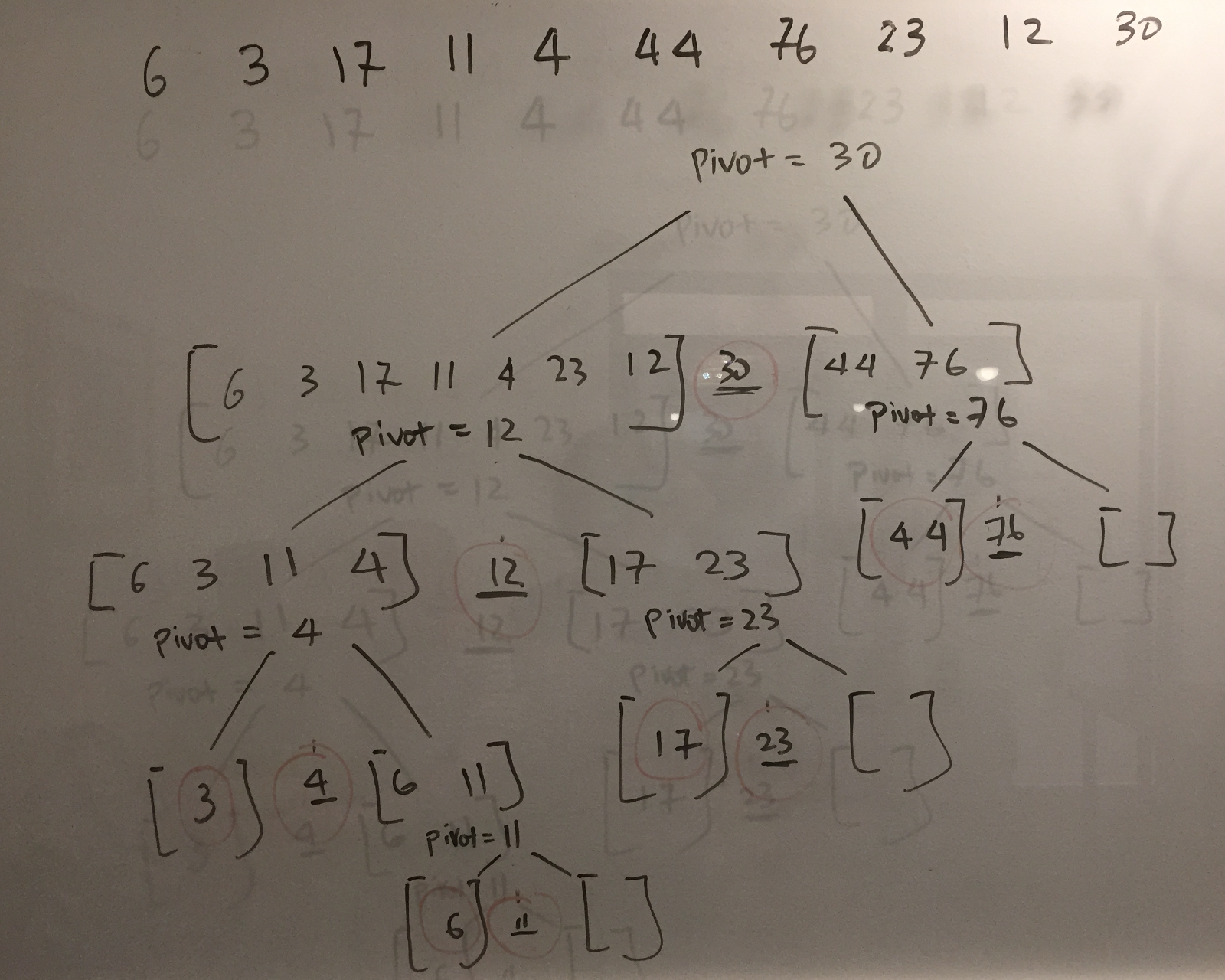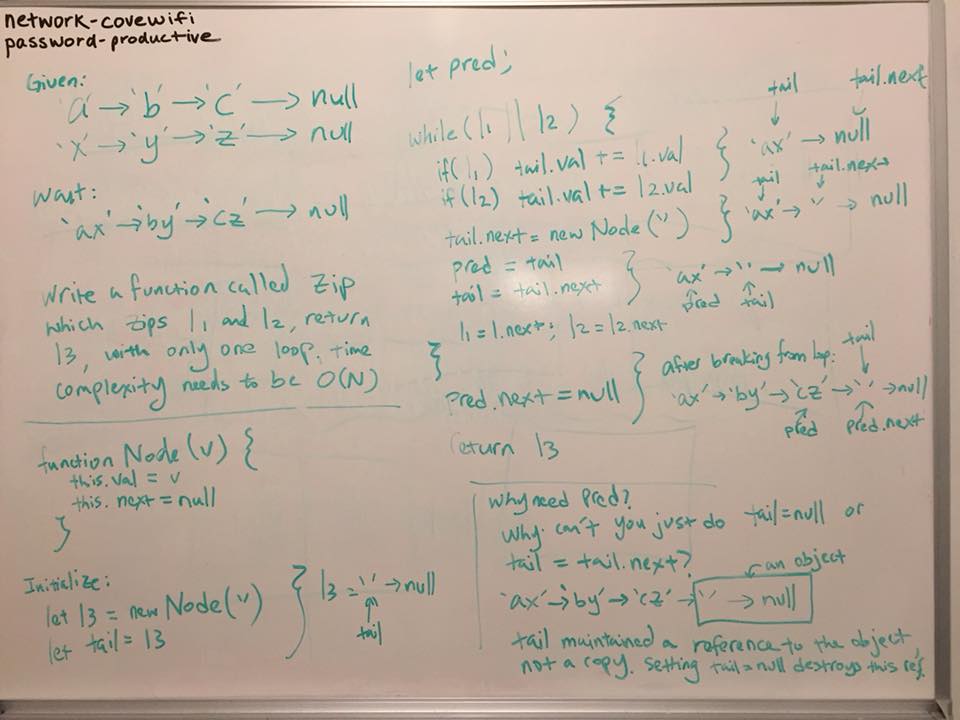Algos to Practice Whiteboarding for The Coding Interview
We are going to go over a set of coding and whiteboard problems that would be asked during a coding interview. I’m drawing these problems from LeetCode and Cracking the Coding Interview. They are a sample of the medium and hard problems that require a bit of thinking and and familiarity with some fundamental data structures in computer science.
LeetCode Practice
- TwoSum - Easy
- MySolution
- Gotcha: you can easily develop a O(N^2) algorithm with a nested loop but we can develop a single-pass O(N) algorithm by creating a hash map
- Knowledge: hash map
- Complexity: O(N^2) or O(N)
- AddTwoNumbers - Medium
- MySolution
- Gotcha: You can add things to the end of the linked list while generating a linked list by creating a hole at the end and keep a
tailreference to that hole. - Knowledge: Linked List
- Complexity: O(N)
- MultiplyStrings - Medium
- MySolution
- Gotcha: A many-step problem that has a lot of room for error. handle your edge cases! The way to solve this problem is to do grade school multiplication. Don’t forget to handle edge condition e.g., one of the two numbers is “0”, return “0” right away.
- Knowledge: arrays and strings, be careful with edge case handling
- Complexity: O(M*N)
- Path Sum II - Medium
- MySolution
- Gotcha:
nodeis a leaf if!node.left && !node.right. Keep a mutable data structure outside of your recursive function to accumulate result. - Knowledge: Graph, binary search tree, depth first search, recursion
- Complexity: O(log N) … height of the tree if perfectly balanced but could be O(N) if not a balanced tree
QuickSort
The Quicksort algo in a nutshell
The quicksort algorithm is a sorting algorithm that sorts a collection by choosing a pivot point, and partitioning the collection around the pivot, so that elements smaller than the pivot are before it, and elements larger than the pivot are after it.
Examples
let arr = [10, 80, 30, 90, 40, 50, 70]
let arr2 = [6, 3, 17, 11, 4, 44, 76, 23, 12, 30]
Whiteboard
The Code
function quicksort(arr) {
//base case
if(arr.length < 2) return arr
// divide an conquer
let subArr = arr
let pivot = subArr.pop()
// work at each level is O(N)
let [left, right] = subArr.partition(e => e < pivot)
//recurse
return quicksort(left).concat(pivot, quicksort(right))
}
// Helper Function
Array.prototype.partition = function(fun) {
let left = []
let right = []
for(let i=0; i < this.length; i++) { //<--- O(N)
if(fun(this[i])) {
left.push(this[i])
} else {
right.push(this[i])
}
}
return [left, right]
}
Analysis
Work at each level of the tree is O(N) because for each pivot, we have to go through each element in the array and determine if it is less than pivot. In the worst case, we are really unlucky with picking the pivot so instead of distributing work evenly between left and right, we leave all the work to one side. This increases the depth of the tree from logN to N. The expected time complexity is O(N logN), where the first N is how much work we do at each level of the tree and logN is the depth of the tree.
Special Note
- In our divide and conquer step, we want to pick
Array.pop, which is a mutator function, because that’s a O(1) operation and gives us both the pivot and the subArr. We could extract the subArr usingarr.slice(0, arr.length-1)but that creates a whole new array, which is O(N) operation. This doesn’t affect the big-O complexity as O(2N logN) is O(N logN) since we drop the constant. - Our quicksort function is not tail recursive. In a compiled language, the compiler will translate the a tail recursive function to a loop so it’s more efficient under the hood. In a real recursion, a new stack frame is built for each function call.
Optimization
The partition logic we just implemented is not smart. It chooses the last element every time. Ideally, we want to choose the median of the array as our pivot so we can evenly offload work to the left and right subproblems.
Another place we can optimize is in space efficiency. Our basic quicksort have us build new arrays (i.e., left and right). Instead of building new arrays, we want to recursively mutate the original array, swapping the elements around until the array is completely sorted.
There are more efficient quicksort implementations that swaps elements in the array.
The names for these are the Hoarse partition and Lomuto partition. Hoarse partition is more efficient than the Lomuto partition. See all the quicksort implementations here.
LinkedList Zip
Write a function zip that takes two linked lists and return a
linked list that is the result of combining the arguments.
Whiteboard
An issue with the whiteboarded code is right before the loop ends, l1 and l2 are incremented. However, one of them could be null. Getting next from null will result in an error. We can fix this by using a conditional ternary operator:
l1 = l1 ? l1.next : l1
l2 = l2 ? l2.next : l2
The Code
function ListNode(val) {
this.val = val;
this.next = null;
}
function zip(l1,l2) {
let l3, tail, pred
// initialize l3
l3 = new ListNode('')
tail = l3
while(l1 || l2) {
if(l1 !== null) tail.val += l1.val
if(l2 !== null) tail.val += l2.val
tail.next = new ListNode('')
pred = tail
tail = tail.next
l1 = l1 ? l1.next : l1
l2 = l2 ? l2.next : l2
}
pred.next = null
return l3
}
Tricks and Shortcut
Convert a string representation of a number to a number:
let s = '2'
typeof s //> "string"
let n = s - '0' //<-- Trick
typeof n //> "number"
Declare an Array and Initialize
const pos = new Array(5);
pos.fill(0) //<-- Shortcut
Fundamental Knowledge Review
Tim Roughgarden’s Algorithms Algorithms: Design and Analysis
Part I
- Divide and Conquer, Sorting and Searching, and Randomized Algo - Integer Multiplication, Karatsuba Multiplication, Merge Sort, Big Oh Notation, O(NlogN) Algorithms for Counting Inversions, Strassen’s Subcubic Matrix Multiplication Algo, O(NlogN) Closest Pair Algo, Quicksort, Randomized Selection Algo, Deterministic Selection Algo, Graphs and Minimum Cuts, Random Contraction Algo, Counting Minimum Cuts
- Graph Search, Shortest Paths, and Data Structures - Graph Search, Breadth First Search (BFS), Shortest Paths, Undirected Connectivity, Depth First Search (DFS) (Topological Sort), Structure of the Web, Dijkstra’s Shortest Path Algo, Heaps, Balanced Search Trees (BST), Red Black Trees, Rotations, Hash Tables, Pathological Data Sets, Universal Hashing, Bloom Filters
Part II
- Greedy Algorithms, Minimum Spanning Trees, and Dynamic Programming - Internet Routing, Sequence, Greedy Algorithms, Optimal Caching, Scheduling, Handling Ties, Prim’s Minimum Spanning Tree (MST) Algo, Kruskal’s MST Algo, Clustering, Advanced Union-Find: Path Compression The Hopcroft Ullman, Advanced Union-Find: The Ackermann Function, Tarjans Analysis, Huffman Codes, Dynamic Programming, the Knapsack Problem: A Dynamic Programming Algo, Sequence Alignment
- NP-Complete Problems - Optimal Binary Search Trees, the Bellman-Ford Algo for Single-Source Shortest Paths and optimal substructure, All-pairs Shortest Paths: The Floyd Warshall Algo, NP-Complete: Polynomial Time Solvable, Reduction and Completeness, Local Search Algo: The Max Cut Problem, The 2-SAT Problem, Random Walks on a Line, Analysis of Papadimitriou’s, Stable Matching.
Resources
- Ben’s Blog - Basic Algos implemented in JavaScript.




